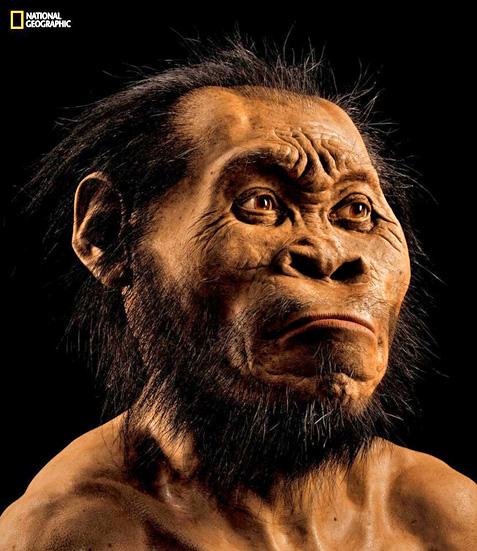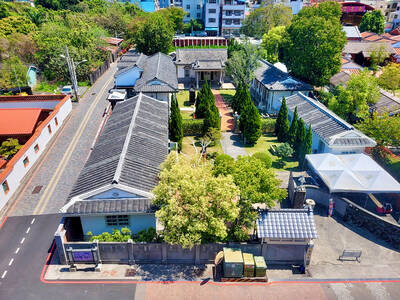Acting on a tip from spelunkers two years ago, scientists in South Africa discovered what the cavers had only dimly glimpsed through a crack in a limestone wall deep in the Rising Star Cave: lots and lots of old bones.
The remains covered the earthen floor beyond the narrow opening. This was, the scientists concluded, a large, dark chamber for the dead of a previously unidentified species of the early human lineage — Homo naledi.
The new hominin species was announced Thursday by an international team of more than 60 scientists led by Lee Berger, a US paleoanthropologist who is a professor of human evolution studies at the University of the Witwatersrand in Johannesburg. The species name, H naledi, refers to the cave where the bones lay undisturbed for so long; “naledi” means “star” in the local Sesotho language.

Photo: AFP Photo/Ho/National Geographic/Mark Thiessen
LARGE FIND, BIG CHALLENGE
In two papers published this week in the open-access journal eLife, the researchers said that the more than 1,550 fossil elements documenting the discovery constituted the largest sample for any hominin species in a single African site, and one of the largest anywhere in the world. Further, the scientists said, that sample is probably a small fraction of the fossils yet to be recovered from the chamber. So far the team has recovered parts of at least 15 individuals.
“With almost every bone in the body represented multiple times, Homo naledi is already practically the best-known fossil member of our lineage,” Berger said.

Photo: AFP photo/Ho/ University of Winsconsin-Madison/John Hawks
The finding, like so many others in science, was the result of pure luck followed by considerable effort.
Two local cavers, Rick Hunter and Steven Tucker, found the narrow entrance to the chamber, measuring no more than 7 1/2 inches wide. They were skinny enough to squeeze through, and in the light of their headlamps they saw the bones all around them. When they showed the fossil pictures to Pedro Boshoff, a caver who is also a geologist, he alerted Berger, who organized an investigation.
Just getting into the chamber and bringing out samples proved to be a huge challenge. The narrow opening was the only way in. Paul Dirks, a geologist at James Cook University in Australia, who was lead author of the journal paper describing the chamber, said the investigators first had a steep climb up a stone block called the Dragon’s Back and then a drop down to the entrance passage — all of this in the total absence of natural light.
For the two extended investigations of the chamber in 2013 and last year, Berger rounded up the international team of scientists and then recruited six excavating scientists through notices on social media. One special requirement: They had to be slender enough to crawl through that crack in the wall.
‘UNDERGROUND ASTRONAUTS’
One of the six, who were all women and were called “underground astronauts,” was Marina Elliott of Simon Fraser University in British Columbia. She said the collection and removal of the fossils involved “some of the most difficult and dangerous conditions ever encountered in the search for human origins.”
Besides introducing a new member of the prehuman family, the discovery suggests that some early hominins intentionally deposited bodies of their dead in a remote and largely inaccessible cave chamber, a behavior previously considered limited to modern humans. Some of the scientists referred to the practice as a ritualized treatment of their dead, but by “ritual” they said they meant a deliberate and repeated practice, not necessarily a kind of religious rite.
“It’s very, very fascinating,” said Ian Tattersall, an authority on human evolution at the American Museum of Natural History in New York, who was not involved in the research. “No question there’s at least one new species here,” he added, “but there may be debate over the Homo designation, though the species is quite different from anything else we have seen.”
A colleague of Tattersall’s at the museum, Eric Delson, who is a professor at Lehman College of the City University of New York, was also impressed, saying, “Berger does it again!”
Delson was referring to Berger’s previous headline discovery, published in 2010, also involving cave deposits near Johannesburg. He found many fewer fossils that time, but enough to conclude that he was looking at a new species, which he named Australopithecus sediba. Geologists said the individuals lived 1.78 million to 1.95 million years ago, when australopithecines and early species of Homo were contemporaries.
Researchers analyzing the H. naledi fossils have not yet nailed down their age, which is difficult to measure because of the muddled chamber sediments and the absence of other fauna remains nearby. Some of its primitive anatomy, like a brain no larger than an average orange, Berger said, indicated that the species evolved near or at the root of the Homo genus, meaning it must be in excess of 2.5 million to 2.8 million years old. Geologists think the cave is no older than 3 million years.

April 28 to May 4 During the Japanese colonial era, a city’s “first” high school typically served Japanese students, while Taiwanese attended the “second” high school. Only in Taichung was this reversed. That’s because when Taichung First High School opened its doors on May 1, 1915 to serve Taiwanese students who were previously barred from secondary education, it was the only high school in town. Former principal Hideo Azukisawa threatened to quit when the government in 1922 attempted to transfer the “first” designation to a new local high school for Japanese students, leading to this unusual situation. Prior to the Taichung First

Chinese Nationalist Party (KMT) Chairman Eric Chu (朱立倫) hatched a bold plan to charge forward and seize the initiative when he held a protest in front of the Taipei City Prosecutors’ Office. Though risky, because illegal, its success would help tackle at least six problems facing both himself and the KMT. What he did not see coming was Taipei Mayor Chiang Wan-an (將萬安) tripping him up out of the gate. In spite of Chu being the most consequential and successful KMT chairman since the early 2010s — arguably saving the party from financial ruin and restoring its electoral viability —

The Ministry of Education last month proposed a nationwide ban on mobile devices in schools, aiming to curb concerns over student phone addiction. Under the revised regulation, which will take effect in August, teachers and schools will be required to collect mobile devices — including phones, laptops and wearables devices — for safekeeping during school hours, unless they are being used for educational purposes. For Chang Fong-ching (張鳳琴), the ban will have a positive impact. “It’s a good move,” says the professor in the department of

Toward the outside edge of Taichung City, in Wufeng District (霧峰去), sits a sprawling collection of single-story buildings with tiled roofs belonging to the Wufeng Lin (霧峰林家) family, who rose to prominence through success in military, commercial, and artistic endeavors in the 19th century. Most of these buildings have brick walls and tiled roofs in the traditional reddish-brown color, but in the middle is one incongruous property with bright white walls and a black tiled roof: Yipu Garden (頤圃). Purists may scoff at the Japanese-style exterior and its radical departure from the Fujianese architectural style of the surrounding buildings. However, the property